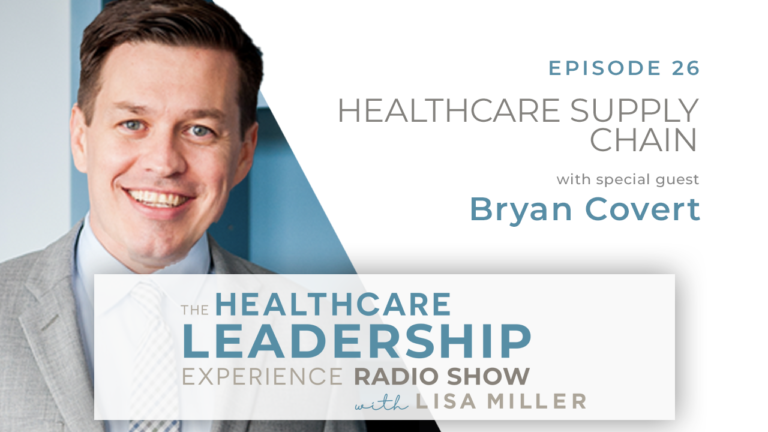Do you know the trends in healthcare that indicate a cost management issue?
In Episode 28 of The Healthcare Leadership Experience, Lisa is joined by Lisa Larter from The Lisa Larter Group to discuss current trends in healthcare.
As Lisa observes: ‘’…in purchased services the …whole approach has been, how do we place purchased services in a box? Well, I’m here to tell you it’s not easy,…because…. all your spend is on your invoices.’’
This episode is sponsored by VIE Healthcare Consulting® which has proudly helped hospitals save $772 million since 1999.
In today’s episode you’ll hear:
- The big winners who stayed focused on financial performance throughout the pandemic and saved millions of dollars ‘’…they pushed through industry norms and were okay with being uncomfortable.’’
- The reasons hospitals partner with VIE Healthcare® to save money, including:
- Benchmarking reveals the financial gaps they want to close.
- The need to find new areas to optimize spend in their deficit.
- When executives need a reset on contract spend.
- The warning signs that indicate a cost management issue. Hint: Unexpected vendor price increases are a challenge.
- How psychology gets in the way of high performance – or to quote Tony Robbins, “… they either have a strategy problem… or a psychology problem.’’
- Why there is more to identifying cost savings in purchased services than categorization and ratio benchmarking. “The reality is purchase services is a roll up your sleeves, digging into 12 months of invoices. …it has to be a line item approach.”
- The power of a self-contracting strategy for healthcare organizations. “GPO pricing may not always be the best pricing. When it comes to PPIs, high cost supplies and purchased services, hospitals will do better self-contracting.“
- Discover the technology that gives every healthcare executive access to their line item details.
The Healthcare Leadership Experience is going live on Healthcare Now Radio in 2022! Stay tuned to learn more!
Discover the benefits of launching your own hospital podcast. Listen again to Episode 27 of The Healthcare Leadership Experience.
Connect with Lisa:
📧 lmiller@spendmend.com
📱https://www.linkedin.com/in/lisamiller/
Episode Transcripts
CLICK HERE TO DOWNLOAD THE PDF TRANSCRIPT
CLICK HERE TO OPEN THE FULL TRANSCRIPT
Lisa Miller (00:00): There’s a couple of areas in non-labor expenses that really have to be looked at. We double down a lot on physician preference items, because there’s so much change in that space, whether it’s pricing new product or, you know, physician utilization, but in purchase services, there’s been a lot more focus on that recently in the past few years, however, the approach has been wrong. The whole approach has been, how do we place purchase services in a box and make it easy? Well, I’m here to tell you it’s not easy to put purchase services in a box because the line item details, all your spend is on your invoices. So best practices that hospitals need to embrace is you have to go beyond categorization and you have to go beyond oversimplified ratio benchmarking. You need a line item approach, that is a must. Announcer (01:01): Welcome to the Healthcare Leadership Experience, a place where healthcare leaders will share proven strategies and innovative approaches to leading the clinical and business side of healthcare. This show is sponsored by VIE Healthcare Consulting who has proudly helped hospitals save over $700 million in non-labor costs since 1999. Here’s your host, Lisa Miller, founder and CEO of VIE Healthcare. Lisa Miller (01:24): Hello, this is Lisa Miller and I’m the host of the Healthcare Leadership Experience Podcast. And I’m with my podcast producer and marketing strategist, Lisa Larter. I’m gonna change things up for this episode and then our next episode. On this episode, Lisa has requested to interview me on trends and then the following one on predictions in healthcare as a way to wrap up this year and start, uh, the following year. So I’m- I’m excited, Lisa, to have this time where you get to ask me questions and we talk today about trends in healthcare. So welcome. Lisa Larter (02:04): Thanks Lisa. Thanks for having me and thanks for saying yes to doing this a little different. Lisa Miller (02:08): This is great. But so before we get started, I have a special announcement about the show. We have been syndicated on the Healthcare Radio Now for the last, I would say about a month and a half, and starting January, 2022, we are going to change from a podcast to a real radio show. We be aired three times per day on Healthcare Radio Now, and I encourage everybody to go over there for some phenomenal healthcare radio shows and we will be on their radio show on Monday through Friday, uh, three times per week. So I welcome everybody to go over there to listen. We’re also on Apple and Spotify, Pandora and all the other platforms. So Lisa, as we jump in on healthcare trends, I wanna just give a little context, because there were some big winners in 2021 and, you know, 2021 were challenging. Everybody had to focus on COVID and patients and just this whole environment of how to provide healthcare in- in a pandemic. But there have been big winner in 2021. And those are hospitals that stay committed to their financial performance improvement goals and their cost savings work streams. They sort to utilize analytics in a different way, and they pushed through industry norms and were okay with being uncomfortable. So I’ve work with two particular clients, similar in some ways and different in others. One was a small hospital and the other was a midsize system, and they both worked through COVID and were able to achieve remarkable results, cost savings results in the midst of being in a pandemic and in the midst of having to do those things that other hospitals had to do as well. And the small hospital took out $3.2 million in cost savings in 14 months and a larger one took over $10 million in 14 months. A 3.2 million in 14 months and 10.1 million in 14 months, both during COVID, when the pandemic started and in the worst time for hospitals. So I wanna say there were some big winners that decided to stay the course to keep their initiatives, and those are the hospitals now that have a little bit of cushion as they enter 2022. And we’ll talk more about that on today’s show. So Lisa, I’ll let you take it over now. Lisa Larter (04:43): Awesome. Thank you. I also just wanna acknowledge that we are on episode 28, that is amazing, like 28 episodes deep, which is just fantastic. So Lisa, you have been working as a strategic advisor and consultant with senior leaders and executives in healthcare for over two decades, and I know how passionate you are about the work that you do. You have helped hospitals save six, seven, and even eight figures in unnecessary purchase services spend during that time, and I know that you have helped them save, in total, more than a billion dollars in savings. So I’d like to discuss some of the trends that you have seen that healthcare leaders really should pay attention to. So let’s start by acknowledging that it takes strong leadership to seek outside help and expertise in any type of industry. So what are the three biggest reasons that healthcare leaders seek your help? And just to kinda piggyback on that, why do you think these leaders seek help around these trends that you have identified instead of ignoring them? Lisa Miller (06:00): That’s a great question. And I think probably more than three, but I’ll kind of buzz through them a little quickly. So number one, they’ve been benchmarked in some way, shape or form, and, you know, there’s different ways that they can look at their peers and they’ve come up with some gaps and they’ve seen themselves maybe fall a little short. So they want to close that gap and they need outside expertise. And number two, they already have a margin gap. So it’s already there, they have a deficit and they need every area looked at. They need to find new areas to optimize, they, you can’t tap those same areas. We have this fatigue around certain areas that keep on getting looked and looked because they’re comfortable and we gotta move to the uncomfortable that haven’t been looked at. You know, it’s interesting, I hear a lot when I speak to healthcare leaders and they have a hunch something’s off, they just kind of a feeling that their contracts need to be reviewed, they have a have been benchmark, or just something feels off or they have this large contract and very concerned about. We get a lot of those calls that they just need a review or help with the resetting, the- the analysis, because it’s such a large percentage of their spend. Interestingly enough, we get leaders that also wanna buffer with their vendors for negotiate. They know they need to do certain things, but they don’t wanna be the ones to do it. And it doesn’t mean that anyone’s bad or not incapable, but, you know, it’s- it’s a smart strategic decision to wanna have a buffer and they are, the hospitals and our clients are involved, but sometimes they’re a bit removed in certain aspects. So they- Lisa Larter (07:37): So you act as that buffer for them? Lisa Miller (07:40): Yeah, absolutely. And recently, you know, just this past week, we had a hospital say to us that they appreciate the fact that we are the buffer. You know, in some cases these are services or relationships or the vendors are in every day and, you know, they- they appreciate the relationship, but they also know that they need to have better pricing or they need a better contractor, they need better structure and they- they really appreciate that. So we get lots of feedback on that con- that part of the conversation. And lastly, I think two things, lastly, they have a big strategic goal they have to achieve, right? So they’re high performers. And then secondly, they’re concerned about the environment, they wanna be anticipatory. Lisa Larter (08:25): So over the last decade, let’s say, ’cause, you’ve experienced it, you know, expands past that, what are some of the warning signs that you have repeatedly seen that indicate a hospital might have a problem with their spend? And in your experience, who’s the first person inside of the organization to notice this warning sign and are there barriers potentially to getting the message to leaders and decision makers? Lisa Miller (08:57): That’s a great question. So I think the warning signs are, expenses by department are higher, they’re increasing, their budgets are off. They have performed some kind of deep analytics review of their surgical case profitability, or they’re looking at diagnostic test profitability and they’re upside down or thin margins. You know, those are, I think those initial warning signs or they have contracts and vendors that seem to be increasing or they get vendors asking for amendment for more money, they’re hearing from managers that their physicians are making more request for implants or equipment that are similar, so they have two and three of the same products implants. And I think the first people, I think that see this are the VPs of finance or the directors of finance. And so I think they are at the front lines of saying, “Okay, something’s off.” Because they’re in charge of the budget, they work with the expenses in the department and, you know, the- the barriers to maybe why they are not getting these initiatives looked at, at least quickly until they’re maybe a bigger issue is that there’s a reason for it. You know, it’s, there’s an excuse, there’s a reason for that, and everyone’s got a reason for it or we can’t do anything about it. Lisa Larter (10:17): Reasons or rationalizations. (laughs). Lisa Miller (10:19): Yeah. Re-reason to rational. Exactly. It’s interesting because a CFO recently said to me, “You know, we’re not embracing the data, we don’t wanna ruffle feathers and we take too much pride in ownership.” And I think that CFO sums it up very, very well. And sometimes they don’t wanna hire an outside firm or they have an over reliance on GPOs and Tony Robbin said interestingly enough, um, they either have a strategy problem, which includes an implementation and strategy problem, or a psychology problem, and worse if you have both. So sometimes it’s our psychology that gets in the way of high performance because we make all these excuses. Lisa Larter (11:00): Yeah. That’s really well said, really, really well said. Lisa Miller (11:03): So if you’re just tuning in, you’re listening to the Healthcare Leadership Experience on Healthcare Radio Now. I’m your host Lisa Miller, today I’m joined with Lisa Larter, my producer, and we’re talking about trends in healthcare in 2021 and specifically what has worked for hospitals and what has been some of their challenges. The show is sponsored by VIE Healthcare Consulting, the leader, advisory and analytics for helping hospitals accelerate their margin improvement goals. VIE’s collaborated with healthcare leaders and their teams to accelerate their strategic initiatives and improve their financial performance by over one billion dollars since 1999. So Lisa, you were asking me some questions today and- and letting you continue the discussion. Lisa Larter (11:50): Yeah. I love everything that you have had to say. I think that it’s super, super, super interesting to hear some of the trends that you have observed in healthcare and especially, you know, I- I love what you just said about Tony Robbins and, “You either have a strategy problem which includes implementation or a psychology problem, and it’s even worse if you have both.” Because I think that there’s probably a lot of that that goes on. So I wanna know what is one cost savings planning trend that hospitals really need to embrace from your perspective? On the entrepreneurial side, I could probably give you a dozen things that people need to do when it comes to planning. So I’m really curious to hear your perspective on this in healthcare. Lisa Miller (12:39): Right. So I’ve been doing a lot of thinking about that this past year. And, you know, we have an approach called, uh, the 1080, and the 1080 is really around taking a complete top to bottom review, that’s from your highest dollar expense, all the way to that dollar one, which never gets done, right? A complete review of every single dollar spent, and looking at it in 3- 360 views, that’s the contracts, that includes pricing, the utilization, which is key, and then the awareness. So it’s really important as we take a step back, you’ve gotta have a big, big goal, financial goal, cost savings goal. It actually scares you. I actually had one of those for one of our clients in, uh, 2020 and 2021. We were able to achieve it, but scared me and I- I since talked to the CFO about that, and he has actually said, “You probably need to have another scary goal.” You know, and I- I agree with her, but in this review of dollar one to, you know, that your highest dollar expense, you know, the price needs to be looked at, the contracts need to be looked at, the utilization and how we engage physicians in a meaningful way, not when we’re going to ask them something, but way before. You know, it’s interesting when physicians own their surgical centers, their costs for implants are probably the most competitive, but yet in the same hospital, those costs are not as competitive. So we know physicians are such an important part. They can drive costs down, but we have to engage ’em in a real meaningful way, and- and early on. And I also think that there are two things that we don’t talk enough about is measuring and monitoring and how that’s done in a deliberate way, every month and cost awareness. And, you know, uh, I’ve spoken in past episodes about cost awareness, but it needs to be, you know, cost aware for patient care, from physicians through frontline employees. Lisa Larter (14:50): Yeah. That’s so important. Lack of awareness can just cause so many problems, not only inside of organizations, but even in life, right? And when you know better, you do better. So tell me, Lisa, what are a couple of the, let’s say best practices that you’ve seen some of your best clients in healthcare embrace repeatedly to get the best results from their hospital purchase services spend? There’s gotta be some trends related to best practices, things that they do that other hospitals or healthcare leaders don’t do. Lisa Miller (15:29): Yeah. So just to take a back, you know, there’s a couple of areas in non-labor expenses that really have to be looked at. We double down a lot on, uh, physician preference items, because there’s- there’s so much change in that space and whether it’s pricing, new product or, you know, physician utilization. But in purchase services, there’s been a lot more focus on that recently in the past few years, however, the approach has been wrong because the whole approach has been, how do we place purchase services in a box and make it easy? Well, I’m here to tell you it’s not easy to put purchase services in a box, because the line item details, all your spend is on your invoices. So best practices that customers or hospitals need to embrace is you have to go beyond categorization and you have to go beyond oversimplified ratio benchmarking. You can benchmark your purchase services, spend a particular span like EVs to bed size and compare to a small hospital to a big hospital, you’re going to miss out on opportunities, uh, you’re going to frustrate your supply chain team. It- it just can’t be done. So while starting with the categorization is definitely directive, and- and that’s a beginning approach, you need a line item approach. You need a spend map, a 12 month historical data approach. That is a must. For large health systems, there’s different approaches around analytics across all hospitals. What can you do, let’s say for biomed or for reference lab or for a regulated medical ways to look at how each hospital is performing, what they’re doing in this specific hospitals, how you can get, you know, insights, how you can consolidate, how you can manage hospitals across. There are specific system-wide measurement and monitoring system systems that need to be put in place, not just KPIs, but real measuring of spend, focused on critical drivers. And, you know, I think that approach is key because, you know, we tend to wanna put purchase services in a dashboard. We- we always, you know, ma- it makes it easy to sell things, (laughs), right? Lisa Larter (15:29): Right. Lisa Miller (17:56): And the reality is purchase services is a roll up your sleeves, digging into the invoices, digging into 12 months of invoice, that could be thousands of pages. And the fact is it can be done. We- we do that, but it, that approach has to be a line item approach. And I’ll tell you, our clients are getting dramatically different results than those that are using categorization, simplified ratio benchmarking, online RFPs. Our clients are getting two, three, four times the results, because they’re taking a line item approach. Lisa Larter (18:34): That’s great. It’s so important to, you know, really have a plan and to have, you know, historical data and to be looking at those line items and to have really clearly defined KPIs. I think those are best practices for so many organizations. So tell me, what is, this is my final question for you. What is one trend that you’ve seen that healthcare executives are not aware of? It’s like what are those things where you tell them and they’re like, “Well, I didn’t know that,” that they really should be aware of? Lisa Miller (19:08): Oh, wow. Such a tough question. (laughs). So- Lisa Larter (19:11): And I don’t mean it to, like, you know, make- make executives look bad, but I, and we’re talking about trends here. So my assumption is you’ve seen a few things where you assume that they know and- and they don’t, and they’re glad once they know, but what is the one thing that they don’t know that they don’t know, but they should know? Lisa Miller (19:28): Right. I think that there’s a pattern that I’ve seen and we talk a lot about, and, you know, I don’t know if it’s that they don’t know as much as that they need to be reminded or, you know, maybe we’ve gone so far down this road that maybe it isn’t, you know, I- I don’t know, but it’s the power of self-contracting. Hospital have such power or such the abilities to self-contract, but I think that in the advent of GPOs, 20 plus years ago, you know, they were meant to come in and use as a, you know, an aggregate, uh, to help get better pricing, hence why they got the safe harbor protection because they are paid by the vendors,. You know, and there’s- there’s definitely value in those areas where a GPO can aggregate volume. However, there is a large spend, probably more so than not, that the hospitals should be self-contracting. And we’ve gotta go back to that self-contracting strategy. GPO pricing may not always be the best pricing. And in fact, when it comes to some of those PPIs, physician preference items, high cost supplies, and purchase services, the hospitals will do better self-contracting. And there is a role for GPOs, but we also have to remember the funding source and the funding source is the- the vendors pay the GPOs. So self-contracting is such a powerful tool that the hospitals need to be pushing more and more of their spend towards self-contracting. And by doing that, you’ll have second and third order of consequences, which is they’ll be able to be self-reliant, they’ll be able to self-manage and do a lot of things that they don’t do now because they assume that the GPO is handling it. And I think that’s the thing that really is the missed opportunity, is just really thinking, oh, the GPOs got it. We got it covered. We have a high, uh, compliance rate with the GPO. So- Lisa Larter (21:38): Stop assuming, and instead start inspecting what you expect? Lisa Miller (21:42): Yeah, definitely s- stop assuming. Right. It’s really just taking back and [inaudible 00:21:48]. You know, expenses and costs are gonna be a bigger part of hospitals rebounding and closing gaps, they just are. And, you know, we’ve gotta go back to self-contracting, we’ve gotta go back to looking at, even those outsourced physician services agreement, those are, like, outsourced, you know, anesthesiologist service or ER services. And looking at those agreements annually, actually they’re required for compliance to review annually. And by doing that, you know, it’s a nice way to put in your systems other agreements that need to be looked at ann- annually, not just when the contract is coming due. And we have a habit of waiting for a contract renewal to do all that work, and it really should be an annual process of review. Lisa Larter (22:37): And I’ve heard you say before that a lot of executives aren’t and when you tell them about the technology that you have, that allows them to get to line item details so they can have greater insights on what’s happening, that they don’t even realize that this technology is available. Is that true? Lisa Miller (22:53): It is true. I have continued to have weekly calls with healthcare leaders and I explained what we’re doing and we’ve taken it off the shelf, OCR tool, and we’ve customized it, and we’ve patented it to be able to extract the invoice line item details in a structured way and perform analytics. And when we show our hospitals, how quickly within minutes we can extract and analyze their shots. I, you know, it’s unfortunate that, you know, more hospitals, you know, aren’t aware, they think, well, this is just the way it is, but we’re providing some of our clients with unparalleled, like, amazing insights because we’re getting 12, 18 months of historical line item details for some of their most complex purchase services spend, we’re getting them turned around so quickly with insights, benchmarking and a strategy for them to have the best contract for their hospital. Lisa Larter (23:56): That’s great, Lisa. So in summary, what I would say is don’t assume that technology hasn’t advanced with what your ever changing needs are in healthcare, because there are lots of advances. Thanks so much for having this conversation. I’m gonna hand it back over to you to wrap up. Lisa Miller (24:11): Thank you, Lisa. I appreciate the questions. You know, they say that questions are the answers. Good questions lead us to the best answers. So I appreciate the questions today. Thanks everyone for listening to the Healthcare Leadership Experience today. Our previous show, episode 27 was why your hospital needs a podcast and, you know, Lisa and I have, uh, both have podcasts that we really kinda dive in deep about your hospital having your own podcast. So I love podcasting because it allows me to share a lot of what we’re seeing day-to-day to a bigger audience and- and just helping more hospitals and leaders and teams, you know, achieve their goals. Our next episode is episode 29 on our 2022 predictions, email me and let me know what you’d like to see for us to cover in 2022 on the show. And if you aren’t connected with me on LinkedIn, please connect [inaudible 00:25:09], I’d love to share the year with you on LinkedIn. I wish everybody a Merry Christmas, happy holidays, and thank you for your support of the Healthcare Leadership Experience. We’ll talk soon. Leah (25:22): Hi, this is Leah. You were listening to my mom’s podcast, the Healthcare Leadership Experience. Fernando (25:29): Hi, this is Fernando. If you would like to speak with my mom, just email her.











